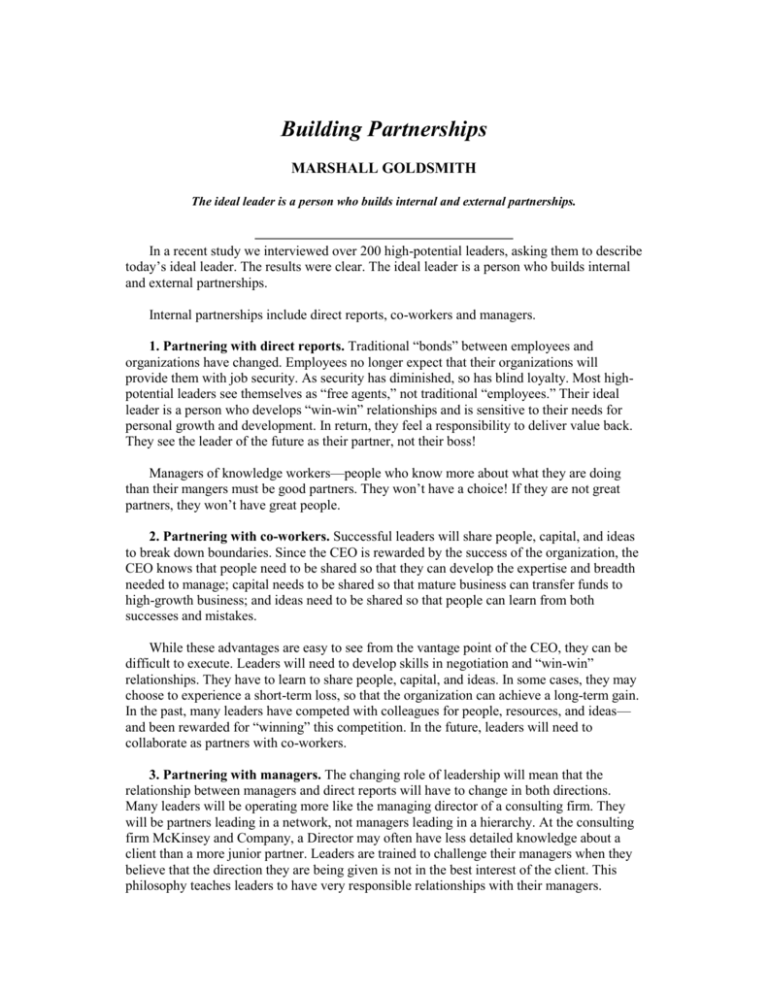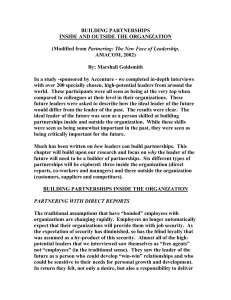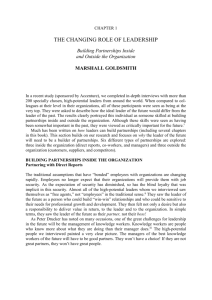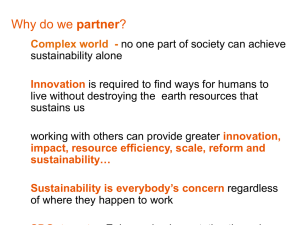Building Partnerships
advertisement

Building Partnerships MARSHALL GOLDSMITH The ideal leader is a person who builds internal and external partnerships. In a recent study we interviewed over 200 high-potential leaders, asking them to describe today’s ideal leader. The results were clear. The ideal leader is a person who builds internal and external partnerships. Internal partnerships include direct reports, co-workers and managers. 1. Partnering with direct reports. Traditional “bonds” between employees and organizations have changed. Employees no longer expect that their organizations will provide them with job security. As security has diminished, so has blind loyalty. Most highpotential leaders see themselves as “free agents,” not traditional “employees.” Their ideal leader is a person who develops “win-win” relationships and is sensitive to their needs for personal growth and development. In return, they feel a responsibility to deliver value back. They see the leader of the future as their partner, not their boss! Managers of knowledge workers—people who know more about what they are doing than their mangers must be good partners. They won’t have a choice! If they are not great partners, they won’t have great people. 2. Partnering with co-workers. Successful leaders will share people, capital, and ideas to break down boundaries. Since the CEO is rewarded by the success of the organization, the CEO knows that people need to be shared so that they can develop the expertise and breadth needed to manage; capital needs to be shared so that mature business can transfer funds to high-growth business; and ideas need to be shared so that people can learn from both successes and mistakes. While these advantages are easy to see from the vantage point of the CEO, they can be difficult to execute. Leaders will need to develop skills in negotiation and “win-win” relationships. They have to learn to share people, capital, and ideas. In some cases, they may choose to experience a short-term loss, so that the organization can achieve a long-term gain. In the past, many leaders have competed with colleagues for people, resources, and ideas— and been rewarded for “winning” this competition. In the future, leaders will need to collaborate as partners with co-workers. 3. Partnering with managers. The changing role of leadership will mean that the relationship between managers and direct reports will have to change in both directions. Many leaders will be operating more like the managing director of a consulting firm. They will be partners leading in a network, not managers leading in a hierarchy. At the consulting firm McKinsey and Company, a Director may often have less detailed knowledge about a client than a more junior partner. Leaders are trained to challenge their managers when they believe that the direction they are being given is not in the best interest of the client. This philosophy teaches leaders to have very responsible relationships with their managers. Future leaders will work with their managers in a team approach that combines the leader’s knowledge of unit operations with the manager’s understanding of larger needs. Such a relationship requires taking responsibility, sharing information, and striving to see both the micro and macro perspective. When direct reports know more than their managers, they have to learn how to “influence up.” Outside the Organization Leaders must also partner with customers, suppliers, and competitors. 1. Partnering with customers. As companies have become larger and more global, there has been a shift from buying stand-alone products to buying integrated solutions. One reason for this shift is economy of scale. Huge retail corporations, like Home Depot or WalMart, do not want to deal with thousands of vendors. They would prefer to work with fewer vendors who can deliver not only products, but systems for delivery that are customized to meet their needs. Also, many customers now want “network solutions,” not just hardware and software. As the supplier’s relationship with their customers continues to change, leaders from supply organizations will need to become more like partners and less like salespeople. This trend toward building long-term customer relationships, not just achieving short-term sales, means that suppliers need to develop a much deeper understanding of the customer’s total business. They will need to make many small sacrifices to achieve a large gain. In short, they will need to act like partners. 2. Partnering with suppliers. As the shift toward integrated solutions advances, leaders will have to change their relationship with suppliers. For example, more of IBM’s business now involves customized solutions incorporating non-IBM products and services. While the idea of IBM selling non-IBM products was almost unheard of in the past, it is now common—to the benefit of customers and, to IBM itself. The same trend is occurring in pharmaceuticals and telecommunications. In a world where a company sold stand-alone products, partnering with suppliers was not only seen as unnecessary, but unethical! The company’s job was to “get the supplier down” to the lowest possible price to increase margins and profitability. Today many leaders realize that their success is directly related to their supplier’s success. In fact, some include commitment to suppliers as one of their core values. They seek to transcend differences and focus on a common good—serving the end user of the product or service. 3. Partnering with competitors. The most radical change in the role of leader as partner has come in partnering with competitors. Most high-potential leaders see competitors as potential customers, suppliers, and partners. Most organizations that rely on knowledge workers have varied and complex relationships with competitors. When today’s competitors may become tomorrow’s customers, the definition of “winning” changes. People have memories. Unfairly “bashing” competitors to ruin their business could have harsh consequences. While competitors should not expect collusion or unfair practices, they should expect integrity and fair dealing. The six trends toward more partnering are reinforcing each other. As people feel less job security, they begin to see suppliers, customers and competitors as potential employers. The fact the leaders need to learn more about these other organizations, build long-term relationships, and develop “win-win” partnerships means that the other organizations are even more likely to hire the leaders. This is often seen as a positive by both organizations. As the trend toward outsourcing increases, it’s difficult to determine who is a customer, supplier, direct report, manager or partner. The leader of the future will need to be skilled at managing these relationships. In many ways, telling direct reports (who know less than we do) what to do is a lot simpler than developing relationships with partners (who know more than we do). Working in a “silo” is simpler than having to build partnerships with peers. “Taking orders” from managers is simpler than having to challenge ideas that don’t meet customer needs. Selling a product to customers is simpler than providing an integrated solution. Getting the lowest price from suppliers is simpler than understanding their complex business needs. Competing with competitors is simpler than having to develop a complex customer-supplier-competitor relationship. The challenge of leadership is growing. Many traditional qualities like integrity, vision, and self-confidence are still needed. But, building partnerships is becoming a requirement, not an option, for future leaders. LE Marshall Goldsmith is the founding director of the Alliance for Strategic Leadership, and authority on helping leaders achieve positive change. marshall@gcnet.com. www.marshallgoldsmith.com.











